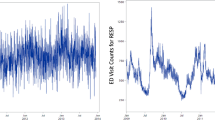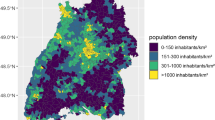Abstract
Epidemiological studies frequently use central site concentrations as surrogates of exposure to air pollutants. Variability in air pollutant infiltration due to differential air exchange rates (AERs) is potentially a major factor affecting the relationship between central site concentrations and actual exposure, and may thus influence observed health risk estimates. In this analysis, we examined AER as an effect modifier of associations between several urban air pollutants and corresponding emergency department (ED) visits for asthma and wheeze during a 4-year study period (January 1999–December 2002) for a 186 ZIP code area in metro Atlanta. We found positive associations for the interaction between AER and pollution on asthma ED visits for both carbon monoxide (CO) and nitrogen oxides (NOx), indicating significant or near-significant effect modification by AER on the pollutant risk-ratio estimates. In contrast, the interaction term between particulate matter (PM)2.5 and AER on asthma ED visits was negative and significant. However, alternative distributional tertile analyses showed PM2.5 and AER epidemiological model results to be similar to those found for NOx and CO (namely, increasing risk ratios (RRs) with increasing AERs when ambient PM2.5 concentrations were below the highest tertile of their distribution). Despite the fact that ozone (O3) was a strong independent predictor of asthma ED visits in our main analysis, we found no O3–AER effect modification. To our knowledge, our findings for CO, NOx, and PM2.5 are the first to provide an indication of short-term (i.e., daily) effect modification of multiple air pollution-related risk associations with daily changes in AER. Although limited to one outcome category in a single large urban locale, the findings suggest that the use of relatively simple and easy-to-derive AER surrogates may reflect intraurban differences in short-term exposures to pollutants of ambient origin.
This is a preview of subscription content, access via your institution
Access options
Subscribe to this journal
Receive 6 print issues and online access
$259.00 per year
only $43.17 per issue
Buy this article
- Purchase on Springer Link
- Instant access to full article PDF
Prices may be subject to local taxes which are calculated during checkout






Similar content being viewed by others
References
Ebelt ST, Wilson WE, Brauer M . Exposure to ambient and nonambient components of particulate matter:a comparison of health effects. Epidemiology 2005; 16: 396–405.
Janssen N, Schwartz J, Zanobetti A, Suh H . Air conditioning and source-specific particles as modifiers of the effect of PM10 on hospital admissions for heart and lung disease. Environ Health Perspect 2002; 110: 43–49.
Meng QY, Turpin BJ, Korn L, Weisel CP, Morandi M, Colome S et al. Influence of ambient (outdoor) sources on residential indoor and personal PM2.5 concentrations: analyses of RIOPA data. J Expo Anal Environ Epidemiol 2005; 15: 17–28.
Sarnat JA, Koutrakis P, Suh HH . Assessing the relationship between personal particulate and gaseous exposures of senior citizens living in Baltimore, MD. J Air Waste Manag Assoc 2000; 50: 1184–1198.
Özkaynak H, Xue J, Spengler J, Wallace L, Pellizzari E, Jenkins P . Personal exposure to airborne particles and metals: results from the Particle TEAM study in Riverside, California. J Expo Anal Environ Epidemiol 1996; 6: 57–78.
Hodas N, Meng Q, Lunden MM, Rich DQ, Ozkaynak H, Baxter LK et al. Variability in the fraction of ambient fine particulate matter found indoors and observed heterogeneity in health effect estimates. J Expos Sci Environ Epidemiol 2012; 22: 448–454.
Klepeis NE, Nelson WC, Ott WR, Robinson JP, Tsang AM, Switzer P et al. The National Human Activity Pattern Survey (NHAPS): a resource for assessing exposure to environmental pollutants. J Expo Anal Environ Epidemiol 2001; 11: 231–252.
Liu DL, Nazaroff WW . Modeling pollutant penetration across building envelopes. Atmos Environ 2001; 35: 4451–4462.
Liu DL, Nazaroff WW . Particle penetration through building cracks. Aerosol Sci Technol 2003; 37: 565–573.
Long C, Suh H, Catalano P, Koutrakis P . Using time- and size-resolved particulate data to quantify indoor penetration and deposition behavior. Env Sci Tech 2001; 35: 2089–2099.
Thatcher TL, Layton DW . Deposition, resuspension, and penetration of particles within a residence. Atmos Environ 1995; 29: 1487–1497.
Chan WR, Price PN, Sohn MD, Gadgil AJ . Analysis of U.S. residential air leakage database 2003.
Persily A, Musser A, Emmerich SJ . Modeled infiltration rate distributions for U.S. housing. Indoor Air 2010; 20: 473–485.
Sherman MH, Chan WR . Building Airtightness: Research and Practice. Lawrence Berkeley National Laboratory: Berkeley, CA. 2004.
Baxter LK, Clougherty JE, Laden F, Levy JI . Predictors of concentrations of nitrogen dioxide, fine particulate matter, and particle constituents inside of lower socioeconomic status urban homes. J Expo Sci Environ Epidemiol 2007; 17: 433–444.
Long CM, Sarnat JA . Indoor-outdoor relationships and infiltration behavior of elemental components of outdoor PM2.5 for Boston-area homes. Aerosol Sci Technol 2004; 38: 91–104.
Zota A, Adarnkiewicz G, Levy JI, Spengler JD . Ventilation in public housing: implications for indoor nitrogen dioxide concentrations. Indoor Air 2005; 15: 393–401.
Meng QY, Turpin BJ, Polidori A, Lee JH, Weisel C, Morandi M et al. PM2.5 of ambient origin: estimates and exposure errors relevant to PM epidemiology. Environ Sci Technol 2005; 39: 5105–5112.
Zeger SL, Thomas D, Dominici F, Samet JM, Schwartz J, Dockery D et al. Exposure measurement error in time-series studies of air pollution: concepts and consequences. Environ Health Perspect 2000; 108: 419–426.
Hoek G, Brunekreef B, Goldbohm S, Fischer P, van den Brandt PA . Association between mortality and indicators of traffic-related air pollution in the Netherlands: a cohort study. Lancet 2002; 360: 1203–1209.
Jerrett M, Burnett RT, Ma RJ, Pope CA, Krewski D, Newbold KB et al. Spatial analysis of air pollution and mortality in Los Angeles. Epidemiology 2005; 16: 727–736.
Poulstrup A, Hansen HL . Use of GIS and exposure modeling as tools in a study of cancer incidence in a population exposed to airborne dioxin. Environ Health Perspect 2004; 112: 1032–1036.
Chen C, Zhao B, Weschler CJ . Assessing the influence of indoor exposure to "outdoor ozone" on the relationship between ozone and short-term mortality in US communities. Environ Health Perspect 2012; 120: 235–240.
Chen C, Zhao B, Weschler CJ . Indoor exposure to "outdoor PM10" assessing its influence on the relationship between pm10 and short-term mortality in US cities. Epidemiology 2012; 23: 870–878.
Levy JI, Chemerynski SM, Sarnat JA . Ozone exposure and mortality: an empiric Bayes metaregression analysis. Epidemiology 2005; 16: 458–465.
Peel JL, Tolbert PE, Klein M, Metzger KB, Flanders WD, Todd K et al. Ambient air pollution and respiratory emergency department visits. Epidemiology 2005; 16: 164–174.
Strickland MJ, Darrow LA, Klein M, Flanders WD, Sarnat JA, Waller LA et al. Short-term associations between ambient air pollutants and pediatric asthma emergency department visits. Am J Resp Crit Care 2010; 182: 307–316.
Sarnat SE, Sarnat JA, Mulholland J, Isakov V, Özkaynak H, Chang H et al. Application of alternative spatiotemporal metrics of ambient air pollution exposure in a time-series epidemiological study in Atlanta. J Expo Sci Environ Epidemiol, (submitted for publication).
Breen MS, Breen M, Williams RW, Schultz BD . Predicting residential air exchange rates from questionnaires and meteorology: model evaluation in Central North Carolina. Environ Sci Technol 2010; 44: 9349–9356.
Chan WR, Price PN, Nazaroff WW, Gadgil AJ . Distribution of residential air leakage: Implications for health outcome of an outdoor toxic release. Indoor Air 2005: Proceedings of the 10th International Conference on Indoor Air Quality and Climate 2005; 1–5: 1729–1733.
Murray DM, Burmaster DE . Residential air exchange rates in the United States: empirical and estimated parametric distributions by season and climatic region. Risk Analysis 1995; 15: 459–465.
Pandian MD, Ott WR, Behar JV . Residential Air exchange-rates for use in indoor air and exposure modeling studies. J Expo Anal Environ Epidemiol 1993; 3: 407–416.
Sherman MH, Matson NE . Air Tightness of New U.S. Houses: A Preliminary Report. Lawrence Berkeley National Laboratory: Berkeley, CA. 2002.
Weisel CP, Zhang JF, Turpin BJ, Morandi MT, Colome S, Stock TH et al Relationships of Indoor, Outdoor, and Personal Air (RIOPA). Health Effects Institute: Boston, MA. 2005.
Wallace L, Williams R . Use of personal-indoor-outdoor sulfur concentrations to estimate the infiltration factor and outdoor exposure factor for individual homes and persons. Environ Sci Technol 2005; 39: 1707–1714.
Haghighat F, Brohus H, Rao JW . Modelling air infiltration due to wind fluctuations: a review. Build Environ 2000; 35: 377–385.
Krieger N . Place, space, and health: GIS and epidemiology. Epidemiology 2003; 14: 384–385.
U.S. Department of Commerce, Bureau of the Census. American Housing Survey 2004.
Sherman MH, Wilson DJ . Relating actual and effective ventilation in determining indoor air quality. Build Environ 1986; 21: 135–144.
Bell ML, Dominici F . Effect modification by community characteristics on the short-term effects of ozone exposure and mortality in 98 US communities. Am J Epidemiol 2008; 167: 986–997.
Medina-Ramon M, Zock JP, Kogevinas M, Sunyer J, Basagana X, Schwartz J et al. Short-term respiratory effects of cleaning exposures in female domestic cleaners. Eur Respir J 2006; 27: 1196–1203.
Weschler CJ . Ozone’s impact on public health: contributions from indoor exposures to ozone and products of ozone-initiated chemistry. Environ Health Perspect 2006; 114: 1489–1496.
Weschler CJ . Ozone in indoor environments: concentration and chemistry. Indoor Air-Int J Indoor Air Qual Climate 2000; 10: 269–288.
Brauer M, Brook J . Ozone personal exposures and health effects for selected groups residing in the Frazer Valley. Atmos Env 1997; 31: 2113–2121.
Acknowledgements
This research was performed under a cooperative agreement between Emory University and the US Environmental Protection Agency (USEPA; CR-83407301-1). Although this work was reviewed by the USEPA and approved for publication, it may not necessarily reflect official Agency policy. The Emory/Georgia Tech team was also supported by funding from a USEPA Clean Air Research Center Grant (RD83479901).
Author information
Authors and Affiliations
Corresponding author
Ethics declarations
Competing interests
The authors declare no conflict of interest.
Rights and permissions
About this article
Cite this article
Sarnat, J., Sarnat, S., Flanders, W. et al. Spatiotemporally resolved air exchange rate as a modifier of acute air pollution-related morbidity in Atlanta. J Expo Sci Environ Epidemiol 23, 606–615 (2013). https://doi.org/10.1038/jes.2013.32
Received:
Accepted:
Published:
Issue Date:
DOI: https://doi.org/10.1038/jes.2013.32
Keywords
This article is cited by
-
Electric vehicle fleet penetration helps address inequalities in air quality and improves environmental justice
Communications Earth & Environment (2023)
-
Indoor-outdoor pollutant concentration modelling: a comprehensive urban air quality and exposure assessment
Air Quality, Atmosphere & Health (2022)
-
A framework for estimating the US mortality burden of fine particulate matter exposure attributable to indoor and outdoor microenvironments
Journal of Exposure Science & Environmental Epidemiology (2020)
-
Comparing health benefit calculations for alternative energy futures
Air Quality, Atmosphere & Health (2020)
-
The impact of air exchange rate on ambient air pollution exposure and inequalities across all residential parcels in Massachusetts
Journal of Exposure Science & Environmental Epidemiology (2019)



